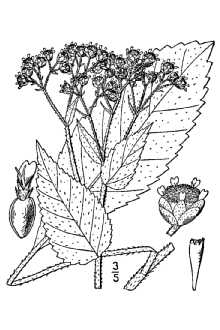Wild Quinine
Scientific Name: Parthenium integrifolium L.

| General Information | |
|---|---|
| Usda Symbol | PAIN3 |
| Group | Dicot |
| Life Cycle | Perennial |
| Growth Habits | Forb/herb |
| Native Locations | PAIN3 |
Plant Guide
Alternate Names
American feverfew, eastern feverfew, eastern parthenium
Uses
Ethnobotanic: The Catawba and other tribes in the southeastern United States used wild quinine for medicinal and veterinary purposes. The leaves contain tannin, which is thought to be beneficial for treating burns. The leaves were mashed into a moist, thick paste, which was then applied as a poultice to burns. Burns were also treated by placing the whole, fresh leaves over the wounded area. Tea from the boiled roots was used to treat dysentery. Ashes from burned leaves were used to rub the skin of horses suffering from sore backs. Other: The flowers make long-lasting additions to cut bouquets.
Status
Please consult the PLANTS Web site and your State Department of Natural Resources for this plant’s current status (e.g. threatened or endangered species, state noxious status, and wetland indicator values). ©William S. Justice @ PLANTS
Weediness
This plant may become weedy or invasive in some regions or habitats and may displace desirable vegetation if not properly managed. Please consult with your local NRCS Field Office, Cooperative Extension Service office, or state natural resource or agricultural department regarding its status and use. Weed information is also available from the PLANTS Web site.
Description
General: Sunflower Family (Asteraceae), Wild quinine is a perennial, herbaceous forb, Stiff, upright, sometimes hairy stems are single, or branched near the top, Stems (4-12 dm in height) grow from a swollen tuberous root, The leaves are ovate to lanceolate with wavy, toothed margins, Basal leaves are 38 cm long, Stem leaves are alternate, smaller, and sparsely distributed along the stems, The long-lasting, somewhat-yarrow-like flower heads are composed of grayish-white, globular, compound flowers that are 4-6 mm wide, Five, unusually short, ray flowers (1-2mm long) surround the central disk flower corollas, which are 2, Use soil moisture sensors to measure the soil moisture of Wild Quinine.,5-3 mm long, Only the ray flowers are fertile, The heads are grouped together into an inflorescent spray up to 20 cm in diameter, Flowers have a pleasant but mild medicinal fragrance, The plant flowers from summer through the autumn months, Distribution: For current distribution, please consult the Plant Profile page for this species on the PLANTS Web site, Habitat: Wild quinine occurs in dry, somewhat heavy soils in prairies, fields, open wooded areas, rocky woods, and hillsides,
Establishment
Wild quinine is a very hardy addition to the garden as it is tolerant of both hot and cold weather. The plants make a nice addition to native plant gardens because of their wild growth form. Wild quinine plants are easily propagated by seed. Plant seeds in the fall or early winter or pre-treat them with 4 to 6 weeks of cold moist stratification to improve germination. Wild quinine will grow best in fertile, well-drained soils in full-sun to light shade.
Pests and Potential Problems
This plant has no known serious disease or insect problems.
Control
Please contact your local agricultural extension specialist or county weed specialist to learn what works best in your area and how to use it safely. Always read label and safety instructions for each control method. Trade names and control measures appear in this document only to provide specific information. USDA, NRCS does not guarantee or warranty the products and control methods named, and other products may be equally effective. Cultivars, Improved, and Selected Materials (and area of origin) These materials are readily available from commercial plant sources. Contact your local Natural Resources Conservation Service (formerly Soil Conservation Service) office for more information. Look in the phone book under ”United States Government.” The Natural Resources Conservation Service will be listed under the subheading “Department of Agriculture.”
